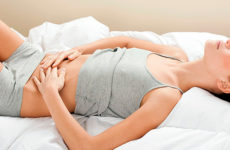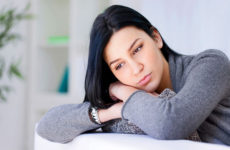The human papillomavirus affects not only adults, but also children, including newborns. Pathological growths can be observed in different parts of the body. How dangerous is the papilloma virus for a baby and how to deal with it? This will be discussed further.

Содержание:
- 1 Varieties of HPV in infants
- 2 Places of localization
- 3 On the face and on the ear
- 4 On hands
- 5 On foot
- 6 On the back
- 7 Armpits
- 8 On the mucous membranes of the mouth
- 9 On the walls of the throat
- 10 Why does HPV occur in babies?
- 11 What is HPV confused with?
- 12 What if the baby was born with HPV?
- 13 Diagnosis of papillomavirus infection
- 14 How to treat HPV in a baby?
- 15 Is the appearance of papillomavirus in an infant dangerous?
- 16 Prevention
Varieties of HPV in infants
In early childhood, the following types of papillomatous neoplasms may appear :
- Filiform . In most cases, these are congenital papillomas that can go unnoticed for a long time, but when rubbed with linen or traumatized during hygiene procedures, they begin to bleed. They have thin legs.
- Simple . Round growths with a rough surface, most often affect the knees, buttocks, back of the hands.
- Flat . Slightly raised above the surface of the skin, dense, flesh-colored. They may be accompanied by itching, and when scratched, they become inflamed.
- Plantar . This type of neoplasm is more typical for children who have already begun to walk. They are located in the area of the sole and look like a corn with dark patches inside. When walking, they can cause pain, tend to merge and spread over large areas.
- Epithelial hyperplasia . observed on the oral mucosa. While eating, they can be damaged, inflamed and hurt.
- Juvenile papillomatosis of the larynx . The place of localization is the back wall of the larynx and the glottis. A rare but very severe pathology that seriously threatens the life of a child. Appears up to a year.
- Warty dysplasia . Diagnosed after 3 years. Red-brown rough spots affect the hands and feet. It is also a rare pathology, dangerous because in 30% it transforms into oncology.
Places of localization
Papillomas in newborns can appear in any area of the skin and mucous membranes. And not always it depends only on the type of neoplasms. Consider the most common places for the appearance of papillomas.
On the face and on the ear
On the face, on the ears, as well as behind them, warts most often appear. In this area, flat papillomas are also possible.

On hands
On the hands most often appear flat growths and vulgar (simple) papillomas. On the hands, the virus can manifest itself as warty dysplasia.
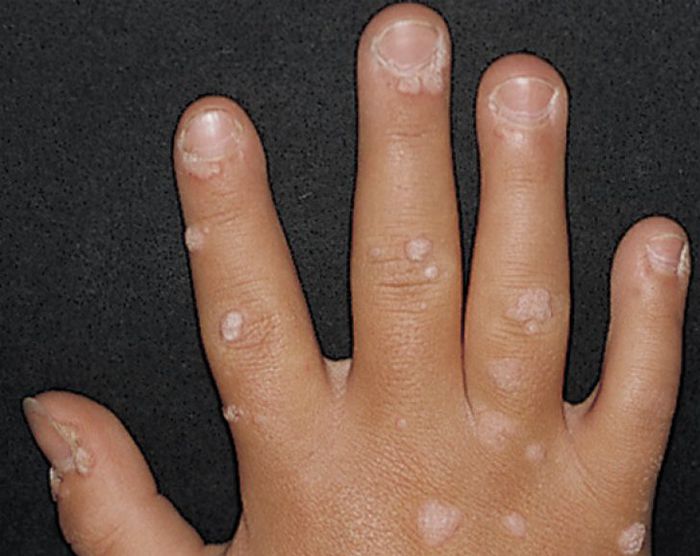
On foot
The child’s legs may suffer from flat papillomas. Perhaps the development of plantar warts or warty dysplasia.
On the back
Papillomas on the back of a baby can appear if the mother had an acute respiratory infection during the bearing of the child. Most often it is warty dysplasia.
Armpits
Filiform papillomas develop on the neck and under the arms . Also, their appearance is possible in the inguinal region.
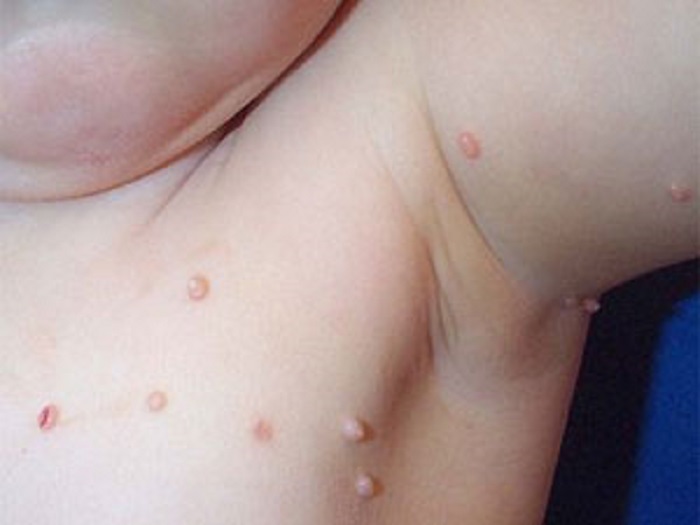
On the mucous membranes of the mouth
Mucous membranes most often suffer from the appearance of filiform papilloma papilloma.
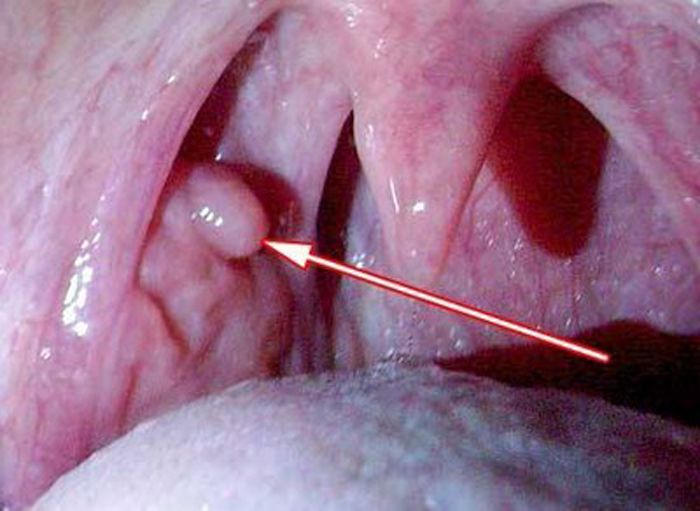
On the walls of the throat
Juvenile papillomatosis develops on the walls of the larynx. It is usually detected at an early age and requires immediate treatment.
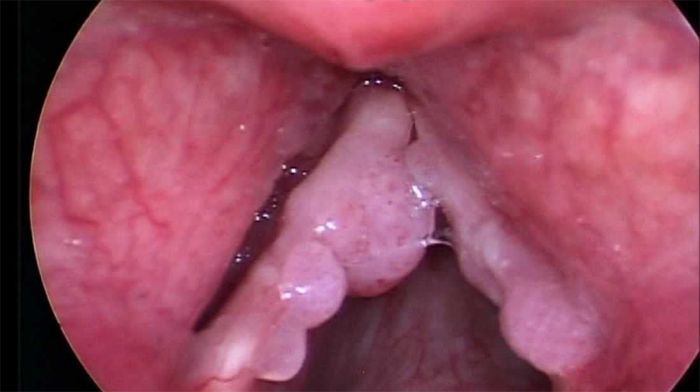
Juvenile papillomatosis of the larynx
Why does HPV occur in babies?
Infection with papillomavirus occurs through contact with the skin, mucous membranes of the patient or carrier, as well as through common items and clothing.
External factors
Even if you accidentally touch the parents’ papilloma, a child can become infected with this dangerous virus. Another variant of infection is also possible – the penetration of the virus into the wounds and scratches of the baby through contact with dishes, toys or other objects.
The risk of developing papilloma in an infant increases significantly if the papilloma is present on the mother’s breast. In this case, the appearance of papilloma of the larynx is not excluded.
Internal factors
The baby can be born already with papilloma. This is possible if the mother had vaginal warts during pregnancy. The child, passing through the birth canal, comes into contact with the infection, and can easily become infected with the virus through the skin with weak protection.
The growth of neoplasms in a baby is directly related to the weakness of the immune system. The growth of growths can provoke the pathology of the gastrointestinal tract, viral and infectious diseases, allergic reactions.
What is HPV confused with?
It is not always possible to recognize HPV at first glance. Similar neoplasms can appear in children in the following cases:
- Molluscum contagiosum . This pathology is often observed in children under 4 years of age. According to clinical signs, the disease is very similar to papilloma – the same tubercles with a leg. But molluscum contagiosum does not pose any danger to the baby, and very quickly passes on its own.
- Nevuses . 60% of moles are congenital.
- Melanoma . This is a serious and dangerous malignant skin disease, most often it develops from benign nevi.
- Skin anomalies of a congenital nature . The development of the papillae of the dermis is not related to HPV in any way.
What if the baby was born with HPV?
Currently, dermatologists are divided into two fundamentally different camps:
- Some believe that the growth in the baby should not be removed, but you just need to observe it, and only with its active growth does it become necessary for surgical removal.
- Others are sure that the papilloma should be removed immediately, because this is the only way to avoid injury, infection and other negative consequences.
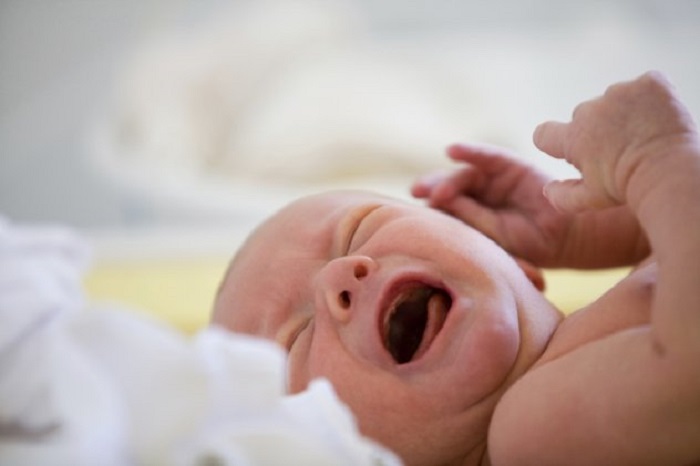
Of course, parents themselves should choose which side to join, however, it must be said that there are more supporters of the second group.
In addition, the papilloma of the larynx must be removed without fail, as it can lead to breathing difficulties and even suffocation.
Diagnosis of papillomavirus infection
Diagnosis of papillomas in newborns is carried out on the basis of the following methods:
- study of clinical signs;
- study of hereditary history;
- examination of the skin and mucous membranes;
- laboratory tests – feces, urine, blood;
- cytological smear;
- colposcopy.
How exactly the diagnosis will be carried out depends on the location of the papilloma. In some cases, when the growths are localized in the anus, rectoscopy is prescribed, and if there is a suspicion of laryngeal papillomatosis , laryngotracheoscopy is performed.
How to treat HPV in a baby?
For the treatment of papillomavirus in a child, different methods are used. However, parents should understand that it will no longer be possible to completely eliminate the virus from the body.
This means that you need to carefully monitor the health of the child, as the virus can become active again and provoke the reappearance of growths.
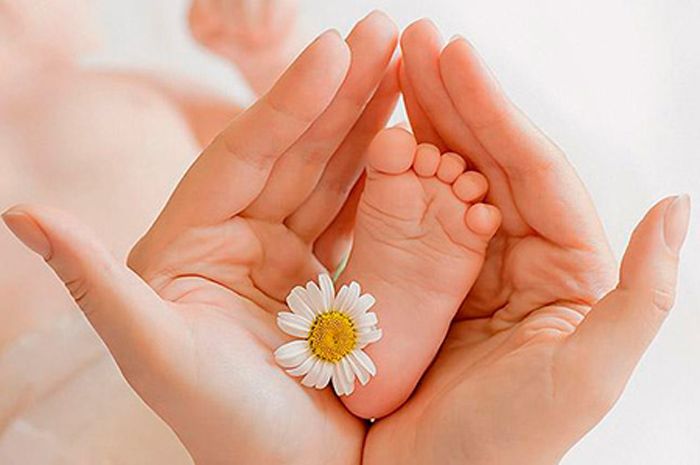
Traditional Therapy
First of all, the doctor prescribes means to increase the immunity of the child, in addition, it is necessary to give the baby vitamins, as well as organize a balanced and nutritious diet.
As for the direct treatment of growths, the doctor may prescribe:
- Imiquimod is a cream that speeds up the healing of papillomas.
- Podofilox – eliminates the destruction of dead cells.
- Viferon is a local immunomodulator.
- Trichloroacetic acid – can only be used by a doctor, as inept use can lead to severe burns.
I must say that the use of local funds will take a lot of time, and in addition, the listed funds cannot be applied to the mucous membranes and the genital area, as irritation may occur.
Surgery
Surgical removal of papillomas in a child is carried out using a scalpel. The growth is removed under local anesthesia.
Physiotherapy
Physiotherapy methods are also effective:
- Cryodestruction – removal by cold.
- Thermocoagulation – pathology is eliminated with the help of high-frequency waves. Most often used to remove growths from the mucosa.
- Laser removal – used for growths on the hands and feet.

Folk methods
Folk methods for a baby should be used with great care and only with the permission of a doctor:
- Celandine juice – be careful, the plant is poisonous!
- Raw potato juice .
- To increase immunity, it is useful for a child to give honey , but only if there is no allergic reaction to bee products.
Is the appearance of papillomavirus in an infant dangerous?
The greatest danger is represented by papillomas, which are localized in the larynx – the child may have difficulty breathing. In addition, it is important to determine the oncogenicity of the virus strain in order to prevent the development of a deadly disease.
Papillomas located in the anus can lead to difficulty in defecation. Also, such papillomas are often injured and infected.
We must not forget about the psychological discomfort that an adult child will experience, especially if the growth is on the face or hands.
Prevention
As for prevention, there are no specific measures in this case. It is very important to maintain the child’s immunity, treat all abrasions and wounds with disinfectant solutions in a timely manner, and prevent stress and strong nervous strains in the baby’s life.
As for congenital papillomas in a child, prevention consists in the mother’s attentive attitude to her health during the bearing of the baby, as well as in pregnancy planning – the treatment of vaginal warts before conception occurs.
Even if the papillomas do not bother the child in any way, they cannot be ignored. Consultation with a dermatologist is required.


